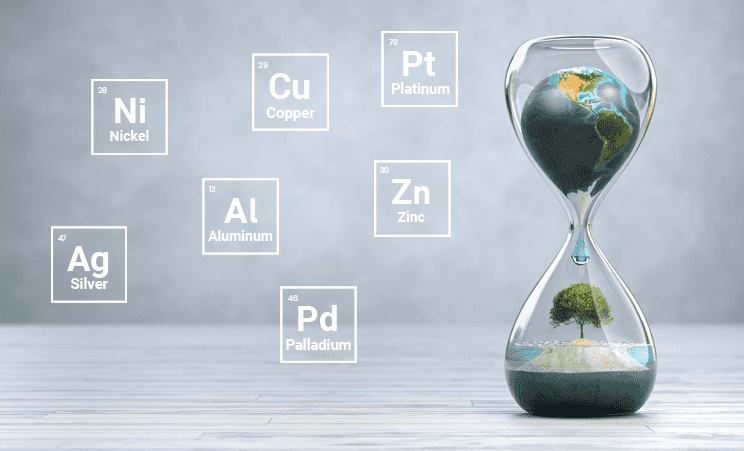RENW Fits as Core Component in Energy Transition Portfolios
February 17, 2023
Over 90% of global GDP is committed to an energy transition, which calls for a massive expansion in renewable energy sources in the coming decades.
Meeting these targets will require commodities that the world simply will not have at current production levels, and the availability of those materials does not seem to have been factored into any commitments.1
Harnessing wind and solar energy, for example, requires far more metals and minerals than fossil fuel plants; for the equivalent MW (megawatt) of generation capacity, offshore wind plants require approx. 8 tons of copper while natural gas needs just 1.1 tons.2
The simple economics of supply and demand argue that the world’s shortfall of these commodities can only be corrected by incentivizing greater production via higher commodity prices, according to Quantix.
Despite the pivotal role that commodities play in the energy transition, equity investments in the space are still far more utilized by advisors than commodity futures-based products, such as the Harbor Energy Transition Strategy ETF (RENW).
Equity investments all effectively short commodities one way or another. Therefore, if an investor wants direct exposure to the commodities that must increase in price to generate new supply (or incentivize other technologies), the only way to do so is by investing in commodity futures directly, according to Quantix.
Commodity futures should be a core component in energy transition portfolios, as they are the cleanest, most direct way of gaining exposure to the expected demand increase for the materials essential for the transition. Commodity futures-based ETFs have the potential for returns that may come from the higher prices required to incentivize new production or new technologies, as well as the positive roll yield associated with commodities in tight supply.
In addition, and crucially for allocators with existing commodity equity investments which are structurally short commodities, a commodity futures allocation can also act as a diversifying hedge, Quantix wrote.
Another upside to commodity futures is that they immediately benefit from a changing supply and demand balance, whereas companies such as commodity products can take 10–15 years to respond with new production, especially in metals.
While the end state of the energy transition is uncertain, some commodities (such as copper) will be necessary irrespective of which technology wins out. Demand for certain commodities (such as the platinum group metals) does depend more on the end state, but investing in companies is inherently a bet on which the underlying technologies wins out, Quantix wrote.
RENW tracks the Quantix Energy Transition index, which includes commodities used in the net-zero end state (such as industrial metals and precious metals), commodities that will be used as transition fuels (such as natural gas and oilseeds), as well as the mechanism for pricing carbon during the transition (such as emissions). Since the theme is a global movement, the index includes commodities from the U.S., Europe, and the U.K.
For more news, information, and analysis, visit the Market Insights Channel.
For more information, please access our website at www.harborcapital.com or contact us at 1-866-313-5549.
1Quantix Commodities, LP, December 2022
2International Energy Agency, March 2022
Important Information
All investments involve risk including the possible loss of principal. Please refer to the Fund’s prospectus for additional risks: RENW.
Commodity and Commodity Linked Derivative Risk: The Fund has exposure to commodities through its and/or the Subsidiary’s investments in commodity-linked derivative instruments. The Fund’s investments in commodity-linked derivative instruments (either directly or through the Subsidiary) and the tracking of an Index comprised of commodity futures may subject the Fund to significantly greater volatility than investments in traditional securities. The Fund is non-diversified and may invest a greater concentrate of its assets in a particular sector of the commodities market (such as metal, gas or emissions products). As a result, the Fund may be more susceptible to risks associated with those sectors.
Authorized Participant Concentration/Trading Risk: Only authorized participants (“APs”) may engage in creation or redemption transactions directly with the Fund.
Energy Transition Risk: The commodities included in the Index may become less representative of energy transition trends over time and the Fund’s investments may be significantly impacted by government and corporate policies.
Foreign Currency Risk: Because the Index may include futures contracts denominated in foreign currencies, the Fund could be subject to currency risk.
The Quantix Energy Transition Index (QET) is an unmanaged index that maintains exposure to at least 10 commodities from its eligible universe of energy transition themes in the United States (U.S.), Canada, United Kingdom (U.K.) and other European exchanges. Commodity futures from the component candidates are selected for the Index and weighted based on QCI’s quantitative methodology. Under normal circumstances, the Index is rebalanced on a monthly basis. The index listed is unmanaged and does not reflect fees and expenses and is not available for direct investment.
Positive roll yield is when a futures market is in backwardation which occurs when a futures contract trades at a higher price as it approaches expiration, compared to when the contract is further away from expiration.
Quantix Commodities, LP is the subadvisor for the Harbor Energy Transition Strategy (RENW).
This article was prepared as Harbor Funds paid sponsorship with VettaFI.
2746981
